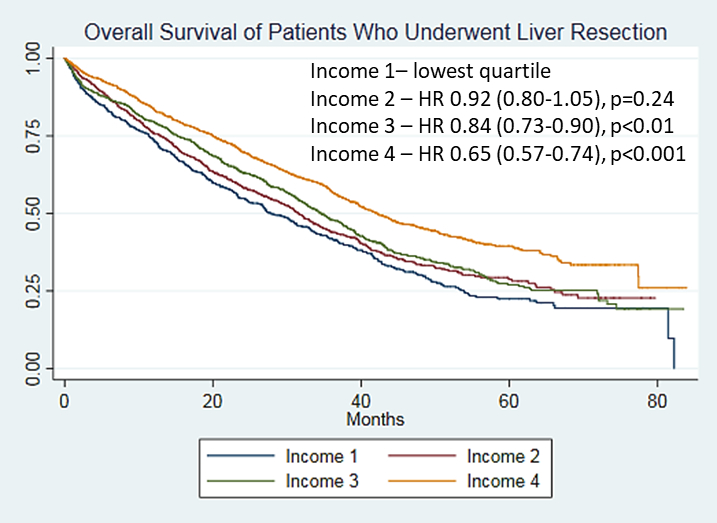THE EFFECT OF INCOME ON SURGICAL TREATMENT OF COLORECTAL LIVER METASTASES
Naomi M. Sell*, Grace C. Lee, Kenneth K. Tanabe, Cristina R. Ferrone, Motaz Qadan
Surgery, Massachusetts General Hospital, Boston, MA
Objective: In patients with newly diagnosed colon adenocarcinoma, 20% will have synchronous metastases to the liver. Metastasectomy, with or without systemic therapy, provides the best chance for cure, and is considered standard practice when feasible. Prior studies have identified inequalities in care provision and overall survival (OS) in colon cancer based on socioeconomic status (SES). We hypothesized that there may be similar differences in rates of resection of colorectal liver metastases based on inequalities of SES as determined by income level.
Methods: The National Cancer Database was utilized to study patients diagnosed with colon adenocarcinoma from 2010-2015. Patients were included if they had synchronous metastases to the liver. Exclusion criteria included extrahepatic disease, history of prior malignancy, and unknown income status. The cohort was divided into quartiles based on median household income ranges adjusted for region and inflation acquired from 2012 census data. The primary outcome was the rate of resection of liver metastases across income quartile. The secondary outcome was OS. Multivariable logistic regression was utilized to determine the odds ratio (OR) of undergoing liver resection, while Kaplan-Meier survival curves and adjusted cox regression were used to compare survival rates between income quartiles.
Results: Of 47,892 patients diagnosed with new primary colon adenocarcinoma and synchronous liver metastases, 25,733 met all inclusion criteria. No significant difference in age or sex was identified between income quartiles. However, there were significant differences in race, insurance status, hospital type, Charlson-Deyo score, and CEA level between income groups (Table 1).
From 25,733 patients, 4,255 (16.5%) underwent resection of their liver metastases. Patients of the highest income quartile were more likely to undergo metastatectomy compared to the lowest quartile (adjusted OR 1.23, CI 1.12-1.37, p<0.001). Overall, patients in the highest income quartile had a median OS of 17.1 months compared with 13.0 months for the lowest quartile (adjusted HR 0.83, CI 0.79-0.83, p<0.001). While metastasectomy is associated with improved OS across all groups, the disparity by income quartile widened, with the highest income patients surviving a median of 29.2 months and the lowest income patients surviving only 22.0 months (adjusted HR 0.65, CI 0.57-0.74, p<0.001, Figure 1). This was despite an unfavorable CEA trend in patients with higher income.
Conclusion: For patients diagnosed with colon adenocarcinoma and synchronous metastases to the liver, higher income patients were more likely to undergo metastasectomy compared with lower income patients and were associated with longer OS. This may be secondary to inconsistencies in referral and management patterns of patients of variable SES, which warrants urgent examination.

Back to 2019 Abstracts




